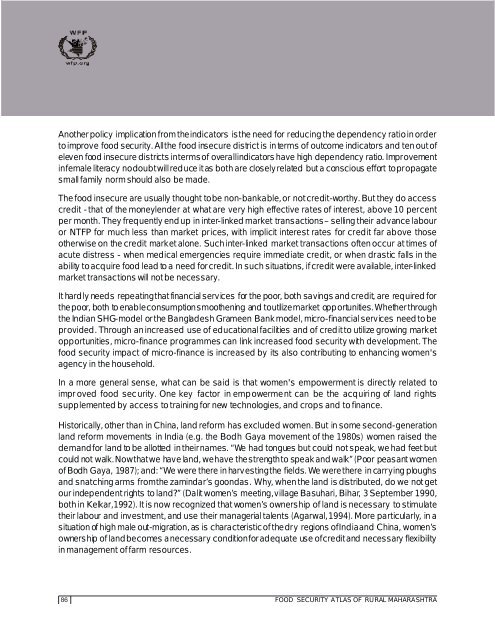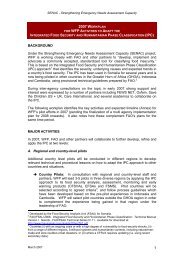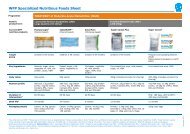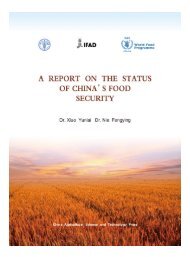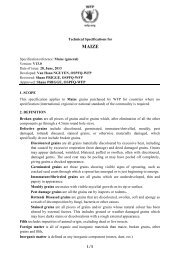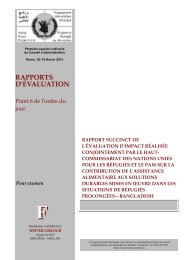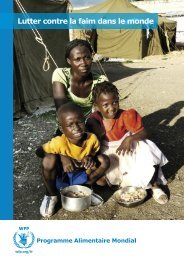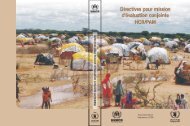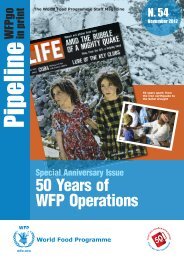Food Security Atlas Of RURAL MAHARASHTRA - WFP Remote ...
Food Security Atlas Of RURAL MAHARASHTRA - WFP Remote ...
Food Security Atlas Of RURAL MAHARASHTRA - WFP Remote ...
You also want an ePaper? Increase the reach of your titles
YUMPU automatically turns print PDFs into web optimized ePapers that Google loves.
Another policy implication from the indicators is the need for reducing the dependency ratio in orderto improve food security. All the food insecure district is in terms of outcome indicators and ten out ofeleven food insecure districts in terms of overall indicators have high dependency ratio. Improvementin female literacy no doubt will reduce it as both are closely related but a conscious effort to propagatesmall family norm should also be made.The food insecure are usually thought to be non-bankable, or not credit-worthy. But they do accesscredit - that of the moneylender at what are very high effective rates of interest, above 10 percentper month. They frequently end up in inter-linked market transactions – selling their advance labouror NTFP for much less than market prices, with implicit interest rates for credit far above thoseotherwise on the credit market alone. Such inter-linked market transactions often occur at times ofacute distress - when medical emergencies require immediate credit, or when drastic falls in theability to acquire food lead to a need for credit. In such situations, if credit were available, inter-linkedmarket transactions will not be necessary.It hardly needs repeating that financial services for the poor, both savings and credit, are required forthe poor, both to enable consumption smoothening and to utilize market opportunities. Whether throughthe Indian SHG-model or the Bangladesh Grameen Bank model, micro-financial services need to beprovided. Through an increased use of educational facilities and of credit to utilize growing marketopportunities, micro-finance programmes can link increased food security with development. Thefood security impact of micro-finance is increased by its also contributing to enhancing women'sagency in the household.In a more general sense, what can be said is that women's empowerment is directly related toimpr oved food security. One key factor in empowerment can be the acquiring of land rightssupplemented by access to training for new technologies, and crops and to finance.Historically, other than in China, land reform has excluded women. But in some second-generationland reform movements in India (e.g. the Bodh Gaya movement of the 1980s) women raised thedemand for land to be allotted in their names. “We had tongues but could not speak, we had feet butcould not walk. Now that we have land, we have the strength to speak and walk” (Poor peasant womenof Bodh Gaya, 1987); and: “We were there in harvesting the fields. We were there in carrying ploughsand snatching arms from the zamindar’s goondas. Why, when the land is distributed, do we not getour independent rights to land?” (Dalit women’s meeting, village Basuhari, Bihar, 3 September 1990,both in Kelkar,1992). It is now recognized that women’s ownership of land is necessary to stimulatetheir labour and investment, and use their managerial talents (Agarwal, 1994). More particularly, in asituation of high male out-migration, as is characteristic of the dry regions of India and China, women’sownership of land becomes a necessary condition for adequate use of credit and necessary flexibilityin management of farm resources.86 FOOD SECURITY ATLAS OF <strong>RURAL</strong> <strong>MAHARASHTRA</strong>


